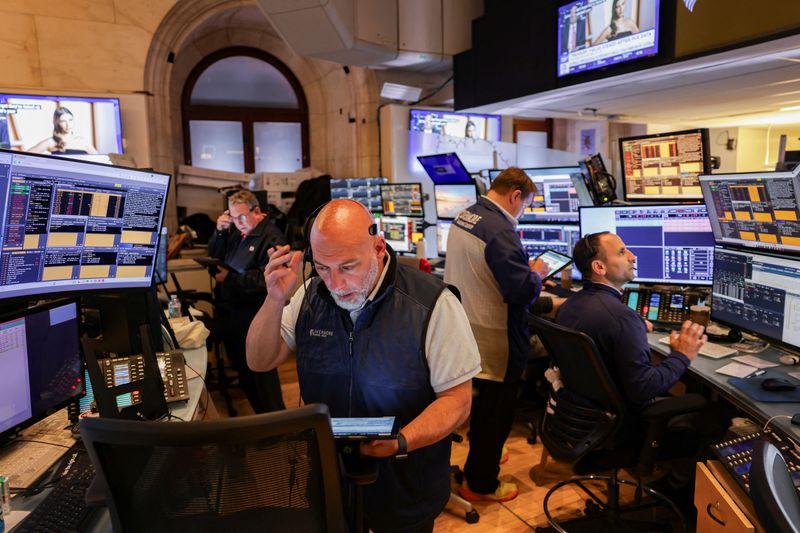Select Language

1. Futures higher
U.S. stock futures pointed higher on Thursday as investors geared up for the release of key consumer price data that could impact the trajectory of Federal Reserve interest rate policy.
By 03:10 ET (07:10 GMT), the Dow futures contract had risen by 35 points, or 0.1%, S&P 500 futures had climbed by 8 points, or 0.1%, and Nasdaq 100 futures had ticked up by 39 points, or 0.2%.
The main averages on Wall Street ended in mixed fashion on Wednesday, with traders gauging a blowout earnings report from artificial intelligence-enhanced cloud software group Oracle and an unexpected fall in producer prices in August which bolstered bets for an imminent Fed rate cut.
Both the benchmark S&P 500 and tech-heavy Nasdaq Composite indices closed at all-time peaks, powered in large part by a surge in Oracle’s shares. The stock spiked by 36% -- its largest one-day gain since 1992 and giving it a market capitalization not far from the $1 trillion mark. The blue-chip Dow Jones Industrial Average, meanwhile, dropped by 0.48%.
2. CPI ahead
Attention is turning to the consumer price index for August, a crucial gauge of inflationary pressures.
The data from the Labor Department’s Bureau of Labor Statistics is anticipated to show that prices grew at an annualized rate of 2.9% in August, accelerating slightly from 2.7% in July.
At that level, the Fed would likely be facing simultaneous threats to both sides of its dual mandate -- maximizing employment and maintaining price stability, defined as a long-run inflation rate of 2%.
This would leave policymakers with the knotty task of simultaneously addressing a cooling labor market and sticky prices, an economic situation that could threaten to edge into a period of "stagflation" marked by high inflation, tepid growth and elevated unemployment.
However, a separate report on Wednesday showed a surprise decline in U.S. factory-gate prices in August. Analysts highlighted that prices in tariff-exposed categories in particular were relatively muted.
So far, Fed officials, including Chair Jerome Powell, have indicated that they are likely to prioritize the labor market’s easing over inflation. A rate cut could in theory spur more investment and hiring, albeit at the risk of fueling price growth.
3. ECB decision
Prior to the Fed’s decision at its September 16-17 gathering, the European Central Bank is scheduled to unveil its own rate announcement on Thursday.
The ECB is widely anticipated to leave borrowing costs unchanged. However, analysts at ING noted that the debate between supporters of keeping rates steady and those in favor of a cut "will likely be more heated than markets have priced in."
Perceived hawkish commentary from ECB President Christine Lagarde in July has weighed on expectations for impending rate moves, with the central bank eyeing slightly higher-than-anticipated inflationary pressures since its last gathering and faster-than-expected economic growth.
These developments, along with ongoing uncertainty over U.S. tariffs, have fueled bets that the ECB will provide little clear guidance around its own policy trajectory -- and will back keeping its key deposit rate unaltered at 2% for a second straight meeting.
4. Adobe to report
Headlining the earnings calendar will be software tools provider Adobe, who will report its quarterly returns after the closing bell.
Sentiment around the firm behind the Photoshop image editor and Acrobat Pro file manager is negative, with many investors flagging that Adobe faces "significant cyclical and secular headwinds," analysts at Vital Knowledge said in a note.
The company is seen posting fiscal third-quarter earnings per share of $5.18 on sales of $5.91 billion, Bloomberg consensus estimates showed.
In June, San Jose-based Adobe raised its annual financial guidance, but observers fretted over when the business could begin to see results from its adoption of AI.
5. Oil inches down
Oil prices slipped lower on weak demand in the United States, after logging strong gains this week on heightened geopolitical tensions in Russia and the Middle East.
At 03:36 ET, Brent futures dropped 0.1% to $67.40 a barrel, and U.S. West Texas Intermediate crude futures fell 0.2% to $63.56 a barrel.
U.S. crude inventories rose by 3.9 million barrels in the week to September 5, the Energy Information Administration said late Wednesday, against expectations of a draw of 1 million barrels.
Gasoline stocks also rose, adding 1.5 million barrels, against expectations of a draw of 200,000 barrels.
Evidence of a slowing U.S. economy will raise concerns that demand in the largest energy consumer in the world is set to slow as the year progresses.
Elsewhere, gold prices edged down amid investor caution prior to the U.S. consumer price report, but the yellow metal stayed close to record highs on firm expectations that the Fed will cut interest rates next week.
Bullion is particularly sensitive to borrowing costs, as lower rates reduce the opportunity cost of holding the non-yielding asset.

